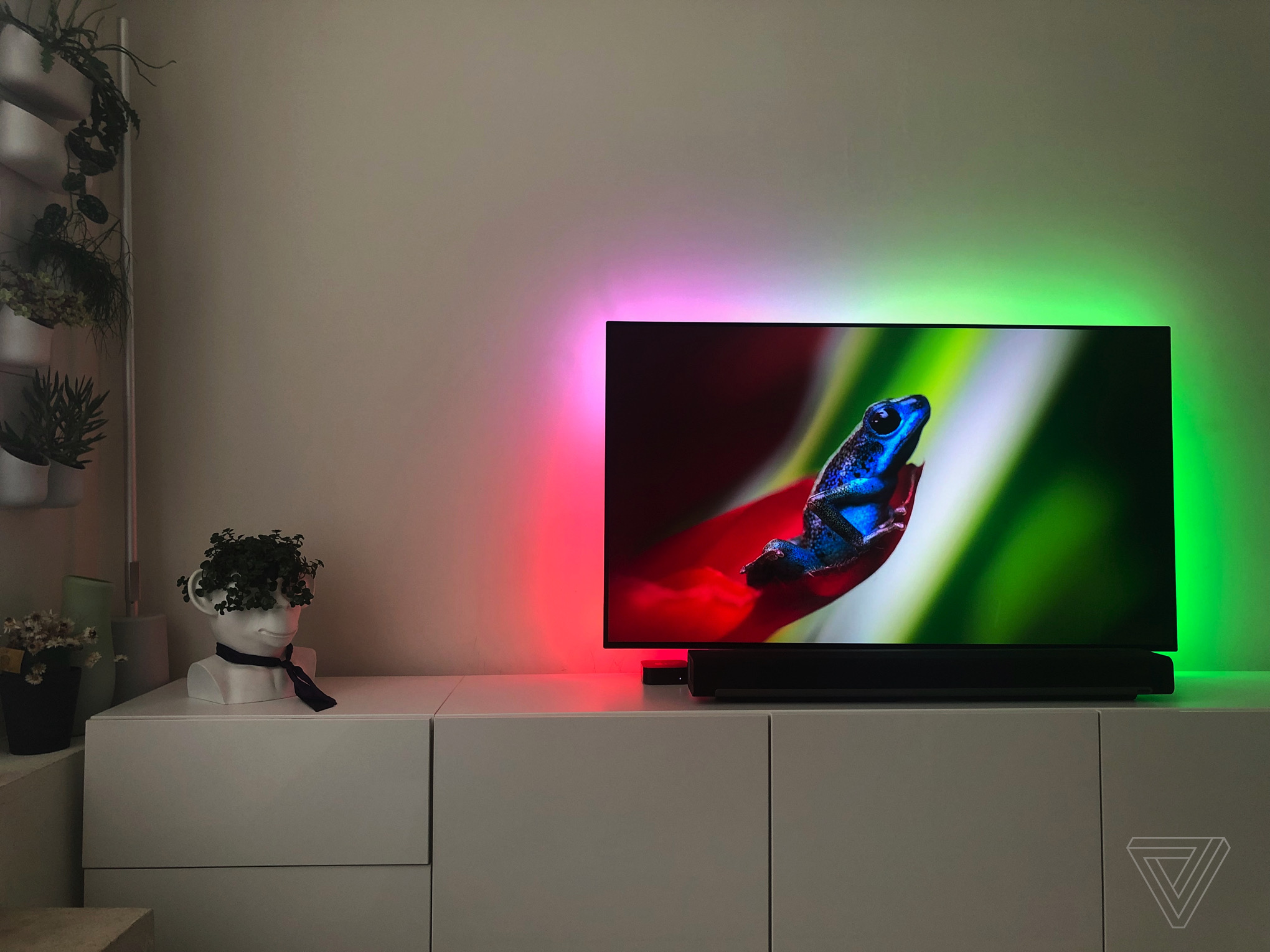I’ve been intrigued by Philips’ Ambilight televisions for almost two decades. Watching those displays bleed onto the wall in radiant synchronicity is something to behold. I just couldn’t justify the price premium, despite the promise of a more immersive viewing experience. Then Philips Hue introduced an external Hue Play Box that adds Ambilight to any TV. But at $229 and requiring you to buy lights to use with it, it was still too expensive for my cheap ass.
A few months ago, I discovered the Immersion TV backlight while checking out Govee’s new Lyra free-standing lamp. The Lyra is cool, but Govee’s Immersion backlight kit seemed like the stuff of my budget-priced dreams. Together, they can transform a bland living room into a hyper-chromatic party. At $80 (and sometimes less if you find it on sale), including all of the components you need to make it work, short of a TV itself, the Govee Immersion kit offers a much better value proposition than Philips.
Verge Score 8 out of 10

Good Stuff
- Works with any content on display unlike the Hue Play Box
- Added immersion is real
- Great value for money
- Camera can be mounted on top or bottom of TV
Bad Stuff
- Adding stickers to your expensive TV is no fun
- Light interferes with camera when mounted on bottom of TV
- Backlighting distracting for some content
- Installation can be fiddly, requiring patience
Installing the Govee Immersion light kit on the back of my TV took about an hour, mostly because caution is advised when gluing over 12 feet of LED lights to a thin and expensive LG OLED TV. The Immersion light strip is a single strand of RGBIC LEDs that sit atop a layer of strong 3M adhesive. I used masking tape to stage my installation before removing the back of the 3M tape to permanently attach the LEDs around the entire perimeter of the TV.
Even then, I still had to move the left and right LED sections. It was only after turning on the lights that I realized the strips were too close to the left- and right-hand edges making them visible from the front. Fortunately, the strips peeled away easily enough, allowing me to reattach them closer to the center without needing to reheat the 3M tape with a hairdryer.
Govee says the Immersion kit is suitable for TVs between 55 and 65 inches, with the single LED light strip divided into sections measuring 70cm for the sides and 120cm along the top and bottom. For my 55-inch TV, I had to do plenty of twisting and cajoling of the LED strip to make sure the slack looped at the corners wasn’t visible from the front. It was all a bit of trial and error while making liberal use of the adhesive cable clamps included in the kit. Installation should be easier on larger TVs.
The Govee Immersion TV Backlight relies upon an external camera to synchronize the LEDs with any colors it detects on the display. Conversely, the Hue Play Box only works with content fed to it via HDMI. That’s given Govee the advantage for anyone who relies heavily on content sourced directly from apps installed on their smart TV.
Placement of the camera is crucial to the operation as it watches the edges of the display and then maps the colors back to each LED on the strip. All Govee marketing materials suggest that the camera has to sit on top of the TV. It’s only when you open the companion phone app that you learn it can also be placed at the bottom, which looks much better in my setup. My TV is sitting on a cabinet with a soundbar in front that completely hides the camera mounted below. Unfortunately, the soundbar also blocks most of the bottom strip of LEDs so I don’t get the full 360-degree Ambilight experience.
The downside of mounting the camera at the bottom is an increase in light interference, affecting the accuracy of the Immersion backlight colors. In my setup, I have light spilling in from a nearby garden door creating some minor interference. In the image slider below, you can see how the light output of the Govee Lyra affects the Immersion backlight when turned on. Mounting the camera on top of the TV would have mostly avoided this. But for me, I’d rather turn off the light than stare at the camera all day long.



:no_upscale()/cdn.vox-cdn.com/uploads/chorus_asset/file/22705383/IMG_959EC950B2C8_1.jpeg)
:no_upscale()/cdn.vox-cdn.com/uploads/chorus_asset/file/22703043/verge_IMG_8589_2040pxl.jpg)
:no_upscale()/cdn.vox-cdn.com/uploads/chorus_asset/file/22703074/verge_IMG_8615_2040pxl.jpg)
:no_upscale()/cdn.vox-cdn.com/uploads/chorus_asset/file/22703075/verge_IMG_8621_2040pxl.jpg)
:no_upscale()/cdn.vox-cdn.com/uploads/chorus_asset/file/22703104/verge_IMG_8595_2040pxl.jpg)
:no_upscale()/cdn.vox-cdn.com/uploads/chorus_asset/file/22703105/verge_IMG_8670_2040pxl.jpg)